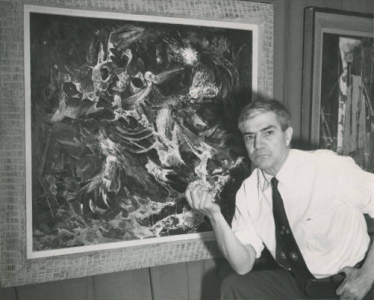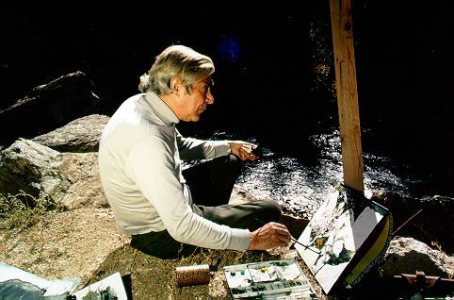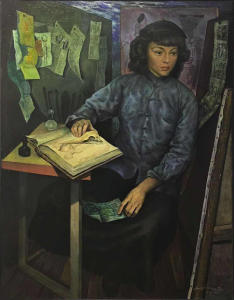

Biography
Xavier Gonzalez was born in Almeria, Spain in 1898, the son of an agricultural expert who traveled widely in Latin America. The family moved to Seville, Spain in 1906 and shortly thereafter to Puebla, Mexico. Xavier studied at the San Carlos Academy while in Mexico City. An early painting of his shows a rural Texas scene and was probably painted on a visit to Texas with his uncle José Arpa, who had been a renowned painter in Spain but was in the process of relocating to Mexico and Texas.
Gonzalez worked as a draftsman for the Inter-Oceanic Railway and the Oro Mining Railroad Company, studying mechanics in a correspondence course. He planned for a time to become an engineer in a gold mine.
He came to the United States in 1922, working first for a railroad in Iowa and then moving to Chicago. There he attended classes at the Art Institute, supporting himself with odd jobs, including a stint designing window displays for the Carson Pirie Scott department store.
In 1923 Gonzalez returned to Mexico for a public school teaching job. But he was back in the United States in 1925, this time for good. He went first to San Antonio, where he assisted his uncle in the art school that Arpa opened in 1926. Meanwhile he taught art at the Witte Memorial Museum (1927-1929). He had a solo exhibition at the Witte in 1928, the first of four such shows he had there over the next four decades.
He moved to New Orleans in 1929, teaching at the Sophie Newcomb College (the women's adjunct to Tulane University) until 1942. His friend Julius Woeltz hired him to run the summer School of Art at Sul Ross State Teachers College in Alpine, TX from 1932-1939. During the 1930s he had other summer teaching jobs and took trips to Europe, meeting Picasso at one point in 1936.
An important commission for Gonzalez was to create eight large murals for the New Orleans Shushan Airport (renamed Lakefront Airport after Mr. Shushan was jailed in a corruption scandal). These murals were rescued from oblivion after hurricane Katrina and are now once again on public display.
Gonzalez married a student of his, Ethel Edwards, in 1935. Edwards was a successful artist in her own right, painting Post Office murals for Lake Providence, LA and Lampasa, TX. She and Gonzalez were mutually supportive as artists and often exhibited their work together.
Gonzalez painted a TVA-themed mural in Huntsville, AL in 1937, and a jazz-themed mural for Dixie's Bar of Music in 1939. That mural is now part of the collection of the New Orleans Jazz Museum. Other mural commissions included Post Office murals for Hammond, LA in 1937, Covington, LA in 1939, Kilgore, TX in 1941, and Mission, TX in 1942.
During World War II Gonzalez served as an art director for the War Department, creating posters and maps for the U.S. Navy. Post-war, he spent ten years on Cape Cod, establishing a summer painting school in Wellfleet, MA and dividing his time subsequently between the Cape and New York City. He painted and lectured at the Metropolitan Museum of Art and taught at the Brooklyn Museum and the Art Students League.
In 1947 Gonzalez was awarded a Guggenheim Fellowship and traveled to Japan. He was a guest instructor at the San Antonio Art Institute in 1951 and artist in residence at Western Reserve University in 1953-1954. In 1955 he laid out his philosophy of art in the publication "Notes on Painting." In 1956 Life Magazine commissioned him to research and paint monuments in Egypt. That series of paintings is now in the Museum of Fine Arts in Boston.
Gonzalez's work was recognized by the National Academy of Design, where he was elected as an Associate member in 1953 and a full Academician in 1955. In 1987 the Academy selected him for the Florence Brevoort-Eickmeyer Prize, awarded by Columbia University. Gonzalez died in New York City in 1993.



Critical Analysis
Gonzalez was a very competent teacher and painter, as attested by his many teaching positions, his numerous commissions, and his various national awards. Interestingly, although he was familiar with the work of the Mexican muralists, and he met Picasso at the time Picasso was starting his work on "Guernica," Gonzalez never produced any work with strong political overtones. Either he was conservative in his personal outlook, or he recognized that sponsors in Texas and Louisiana likely had a very low tolerance for any substantial political dialogue in art.
Gonzalez's Post Office murals are solid classical compositions. But they lack the edginess present in some of the work of his friend, Julius Woeltz. His murals for the Lakefront Airport in New Orleans were a bit of a departure, presenting images in a somewhat dreamy Art Deco style.
But behind this somewhat staid work there lurked more daring impulses. These can be seen in the Jazz Mural painted for Dixie's Bar of Music, where black and white faces mingle with blue and yellow ones in Gonzalez's caricatures of figures in the New Orleans musical scene of that era. And Gonzalez was said to have experimented in private with action painting, à la Jackson Pollock, but he chose not to exhibit those works.
Murals
- Huntsville, Alabama - Federal Courthouse: Tennessee Valley Authority
- Covington, Louisiana - Covington School Board Annex: Tung Oil Industry
- Hammond, Louisiana - Southeastern Louisiana University, Fayard Hall: Strawberry Farming
- Kilgore, Texas - East Texas Oil Museum: Contemporary Youth
- Kilgore, Texas - East Texas Oil Museum: Drilling for Oil
- Kilgore, Texas - East Texas Oil Museum: Music of the Plains
- Kilgore, Texas - East Texas Oil Museum: Pioneer Saga
- Mission, Texas - Mission Historical Museum: West Texas Landscape
References
- Christopher Long, Gonzalez, Xavier (1898–1993), Texas State Historical Association September 1 (1995).
- Robert McClendon, How Hurricane Katrina saved some of New Orleans' most historic art from obscurity, nola.com February 6 (2015).
- John Pope, Lakefront Airport in New Orleans is a 'living museum' of art deco painting and sculpture, nola.com November 23 (2024).
- Camille Barnett, Lakefront Airport’s Art Deco Terminal enters final stage of restoration, Gentilly Messenger November 27 (2019).
- Xavier Gonzalez (Huntsville History Collection).
- Xavier Gonzalez (National Academy of Design).
- John R. Kemp, Xavier Gonzalez, Louisiana Life November 1 (2016).
- Xavier Gonzalez (64 Parishes). By Richard Medgraw.
- Xavier Gonzalez (Vintage Texas Paintings).
- Erika Katayama, Xavier Gonzalez (2009).
- Xavier Gonzalez (Am. 1898-1993) (David Dike Fine Art).